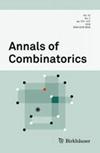欧拉定理的多参数完善
IF 0.7
4区 数学
Q4 MATHEMATICS, APPLIED
引用次数: 0
摘要
欧拉分割定理指出,每个整数被分割成奇数部分的次数和被分割成不同部分的次数一样多。在这项工作中,我们揭示了这一说法背后的一个新的结果。一方面,我们根据出现奇数次的部分的大小的残模4来研究划分为奇数部分。另一方面,我们根据序列中奇数部分的位置讨论了划分为不同部分的问题。同时还考虑了其他一些统计数据,包括长度、交替和和最小奇数除外数。本文章由计算机程序翻译,如有差异,请以英文原文为准。
A Multiparameter Refinement of Euler’s Theorem
Euler’s partition theorem states that every integer has as many partitions into odd parts as into distinct parts. In this work, we reveal a new result behind this statement. On one hand, we study the partitions into odd parts according to the residue modulo 4 of the size of those parts occurring an odd number of times. On the other hand, we discuss the partitions into distinct parts with respect to the position of odd parts in the sequence. Some other statistics are also considered together, including the length, alternating sum and minimal odd excludant.
求助全文
通过发布文献求助,成功后即可免费获取论文全文。
去求助
来源期刊

Annals of Combinatorics
数学-应用数学
CiteScore
1.00
自引率
0.00%
发文量
56
审稿时长
>12 weeks
期刊介绍:
Annals of Combinatorics publishes outstanding contributions to combinatorics with a particular focus on algebraic and analytic combinatorics, as well as the areas of graph and matroid theory. Special regard will be given to new developments and topics of current interest to the community represented by our editorial board.
The scope of Annals of Combinatorics is covered by the following three tracks:
Algebraic Combinatorics:
Enumerative combinatorics, symmetric functions, Schubert calculus / Combinatorial Hopf algebras, cluster algebras, Lie algebras, root systems, Coxeter groups / Discrete geometry, tropical geometry / Discrete dynamical systems / Posets and lattices
Analytic and Algorithmic Combinatorics:
Asymptotic analysis of counting sequences / Bijective combinatorics / Univariate and multivariable singularity analysis / Combinatorics and differential equations / Resolution of hard combinatorial problems by making essential use of computers / Advanced methods for evaluating counting sequences or combinatorial constants / Complexity and decidability aspects of combinatorial sequences / Combinatorial aspects of the analysis of algorithms
Graphs and Matroids:
Structural graph theory, graph minors, graph sparsity, decompositions and colorings / Planar graphs and topological graph theory, geometric representations of graphs / Directed graphs, posets / Metric graph theory / Spectral and algebraic graph theory / Random graphs, extremal graph theory / Matroids, oriented matroids, matroid minors / Algorithmic approaches
 求助内容:
求助内容: 应助结果提醒方式:
应助结果提醒方式:


